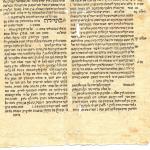Deerfield was attacked on February 29, 1704 during Queen Anne’s War. Four dozen French soldiers and seven score Mohawk Indians assailed the town. Over 140 Deerfield inhabitants were taken captive and put upon a forced march to Fort Chambly in Canada. One cause for the attack included an attempt to take captive into the wilderness the minister of Deerfield, John Williams, who might be exchanged for coveted captives the French wished released from the English during Queen Anne’s War.
A pair of Williams’s children, John (6 years) and Jerusha (1 month), were brutally slain during the attack on Deerfield. Eunice Stoddard Williams, John’s wife, perished on the forced March North into the French Canadian wilderness. John Williams, the minister of Deerfield, and a few of his children were later ransomed back to the English, released, and returned to British imperial civilization.
But not all were redeemed from the wilderness. Eunice Stoddard Williams’ namesake, who was seven years old at captivity, assimilated with the Indians never to return to the English way of life. She married a Mohawk, Arosen, and had three children. Called by her Mohawk name, Kanenstenhawi (Eunice Williams), converted to Roman Catholicism and was baptized Marguerite. All signs in the documentary record indicate that she renegotiated her devout Christianity into a new space and expression of it. While she was no longer Puritan, it appears that she was a wife and mother, who passed on her sincere Christian belief to her children.
Regarding this astonishing cultural conversion, Kathryn Reklis notably remarks, “The coupling of Roman Catholicism and Indian alliance as a fate worse than death in this family drama suggests, albeit primarily in terms of conflict, that Puritan New England was not a self-enclosed enclave but was in fact deeply immersed in the imperial experiments that forced cultures into intimate proximities” (Kathryn Reklis, Theology and the Kinesthetic Imagination, 47.)
Nonetheless, the product of Eunice’s cultural conversion from this clash of cultures was an unwelcome outcome to her family. How could they let the Indians claim one of their own? How could they let the Catholics claim one of their own? How could they let the wilderness claim one of their own?
Her father John Williams, grandfather Solomon Stoddard, and other leading men of New England tried for years to redeem her. Her brother, Stephen Williams, came the closest to successfully redeeming her. In adulthood, Kanenstenhawi visited him on numerous occasions, even bringing her children for an extended stay through a winter.
After her family forsook her, John Schuyler was the first Englishman to broker a meeting with Kanenstenhawi in adulthood. He met with her and her husband, Arosen, in the quarters of the superior priest at the mission, Cholonec. After which he wrote a memorial of the encounter. He described her as “looking very poor in body, bashfull in the face, but proved harder than steel in her breast” (John Demos, The Unredeemed Captive, 104.)
Kanenstenhawi refused to speak but two words during the whole encounter. She stood silent as she listened to Schuyler’s appeals that she return to her home and people of New England. After hearing the whole plea, she responded: “Jaghte oghte” (Maybe not), which was the polite decline of the Mohawk.
John Demos provides a piercing interpretation of why Kanenstenhawi was set against returning to New England. It’s a rather striking interpretation worth sharing at length. It’s truly best understood in the context of having heard the entire account of the captivity. However, I think Demos’s interpretation gets the message across. After the raid on Deerfield and the successive march to Fort Chambly, little seven year old Eunice found refuge in the wilderness after her father forsook her there.
WE WHO READ this “memoriall” almost three centuries later can easily understand the feelings of its author. But what about its subject, the unredeemed captive herself? What were her feelings—held tight, though they were, behind the “steel in her breast”? Her husband gives us a clue, with his reference to her father’s remarriage. And there is, as well, a certain logic in her situation. Otherwise we can only speculate—only imagine—but that much, at least, we must try. So the trader would be here, this very afternoon. She had talked with the headmen, with the priests, with her family: all had assured her that she would be kept safe. Her husband would be with her the whole time; a priest would see the trader first and explain her position. Her home now was the village; her people were the Kahnawake. She would not go back to her English father, not now, not ever.
Her English father: what claim could he possibly make on her anyway? With a clarity born of old bitterness, she remembered the last times she had seen him.
She remembered his coming to the village when she was still a small child—feeling scared and strange, and gripped inside by the ties of her old life. She had begged him then to take her away, but he had failed her utterly. A prayer; some empty words of comfort; a sorrowful good-bye. In her mind’s eye she could still see the back of his bowed head, the heaviness in his step, as he trudged off toward the river.
She remembered the long journey through the forest, up from Deerfield. At first, she had clung to him tightly, as a squirrel clings to a tree; but weak as he was, and clumsy on his snowshoes, he could not walk for the two of them. Then a kind, strong man from the village—a man she knew now as her uncle Hatironta—had swept her up and set her atop his own broad shoulders. And in that position she had traveled almost the entire route to Montreal. When, from time to time, she had turned her head for a glimpse to the rear, she had seen her father lurching heavily through the drifts, falling back, gasping, calling out for rest. The Kahnawake had laughed and joked about him. This tall man with the fine clothes and finer words, this great leader of the “Bastonnais,” this favorite of God: how he had been brought low! Her sorrow for him had turned to pity, and finally to shame.
And there was more. The journey had begun with a terror so extreme that her memory could not sort out the details. But strangely disconnected images remained—images that included herself as though seen by someone else. Herself shocked from sleep, and flung out of bed, in a pitch-dark room—as intruders smashed in the door. Herself squeezed with her English brothers and sisters (shadowy figures now) beneath a bench against a wooden wall. Herself amidst a disordered throng in the meetinghouse, prisoners awaiting an unknown fate. Herself frozen on a trail by a winding river—what trail? what river?—as her mother—what mother?—was led off to be killed. Her father was there, too: there in the dark room, struggling vainly to fire his gun; there in the meetinghouse, eyes raised toward an apparently indifferent God; there by the riverside, helplessly bidding her mother good-bye. (Had he really taken another wife, so soon after his return?) Faithless, forgetful father: protector who could not protect, comforter who would not comfort, caretaker who did not care.
All that was behind her now, far behind. Yet the trader’s coming had brought it back, like the embers of an old fire stirred to life beneath the ash. The priests said she must see him, must give him a hearing. All right: she would see, she would hear. But they couldn’t make her speak. Silence would be her reply; its meaning would be clear enough. (John Demos, The Unredeemed Captive, 108–09)
Demos leaves us with a miserable impression of the Reverend, John Williams, leading figure of the frontier town of Deerfield. He seemed so ill prepared, in body and spirit, for the events that occurred that fateful day on February 29 and the weeks following during the march to Fort Chambly. No doubt, it took much more than a sturdy, spiritually minded soul to endure the kind of life these early New Englanders lived, on the frontier of the Atlantic World. Some were prepared to subdue the wilderness, while other were ill equipped and prepared to endure what the wilderness would demand of them. John Williams, the minister of Deerfield, was the latter sort. Ill-equipped. Ill-prepared.
Yet, somehow, his little seven year old daughter, Eunice, was nurtured by the wilderness. In the wilderness, she cultivated the fortitude to survive the trauma she endured. Upon pieceing together the scattered information we have on Kanenstenhawi, it is apparent that she thrived in the wilderness and navigated a different way of being than the Puritan way. Kanenstenhawi’s choice to remain in the wilderness conveyed that not all who wander into the wilderness are lost.
Kanenstenhawi’s life provided a counter-narrative that threatened and challenged the message of Mary Rowlandson’s captivity account. Rowlandson’s account vindicated the British imperial way of life. It upheld the role of the woman sitting at her hearth in her home. Her account vilified the Native way of life in the wilderness, and exulted in how she was delivered from the dangers and trials of the wilderness. One can see why the British worked feverishly to recover Kanenstenhawi from exile in the wilderness.
Both Puritan women were wrenched from the hallowed space of British domesticity. While one was a mother and the other a child, they both faced significant challenges and had to learn to survive and thrive in an unfamiliar geography. The experience shaped both of them and clarified what they wanted for themselves. Both were given the opportunity to return to the domestic sphere, once they had sampled the ways of the wilderness, but only one returned.
Both derived power from the wilderness and contentment from the home. Mary Rowlandson proclaimed victory over the wilderness and sought solace in her return to British domesticity. Kanenstenhawi conquered the wilderness by embracing it, and found contentment in rejecting British domesticity.
History is filled with stories of bold women like Mary Rowlandson and Kanenstenhawi, women whose circumstances demanded that their devout Christian faith would have to negotiate new and difficult geographies that would test the mettle of their faith.
Some who have had the patience to follow each part of this series might feel compelled to ask the question: Who is the better woman? I think that is the wrong question to ask.
A better series of questions include: What are the geographies of power that women have to negotiate today? How are they negotiating those geographies of power as women? Are women being ineluctably thrust or exiled from one geography of power to another? Why?













